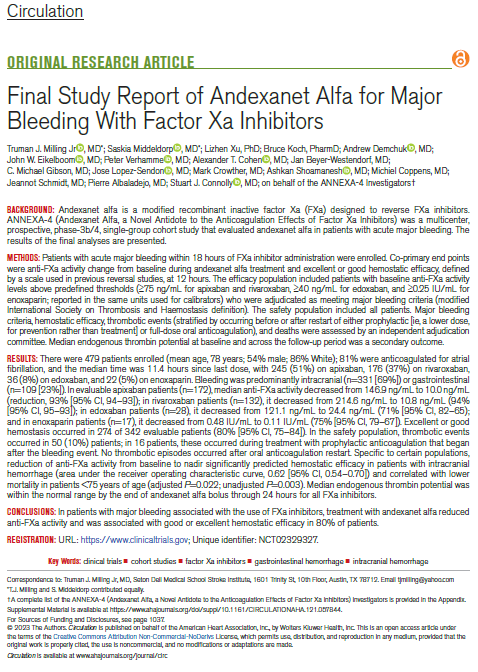Final Study Report of Andexanet Alfa for Major Bleeding With Factor Xa Inhibitors
February 2023
Abstract
Background:
Andexanet alfa is a modified recombinant inactive factor Xa (FXa) designed to reverse FXa inhibitors. ANNEXA-4 (Andexanet Alfa, a Novel Antidote to the Anticoagulation Effects of Factor Xa Inhibitors) was a multicenter, prospective, phase-3b/4, single-group cohort study that evaluated andexanet alfa in patients with acute major bleeding. The results of the final analyses are presented.
Methods:
Patients with acute major bleeding within 18 hours of FXa inhibitor administration were enrolled. Co-primary end points were anti-FXa activity change from baseline during andexanet alfa treatment and excellent or good hemostatic efficacy, defined by a scale used in previous reversal studies, at 12 hours. The efficacy population included patients with baseline anti-FXa activity levels above predefined thresholds (≥75 ng/mL for apixaban and rivaroxaban, ≥40 ng/mL for edoxaban, and ≥0.25 IU/mL for enoxaparin; reported in the same units used for calibrators) who were adjudicated as meeting major bleeding criteria (modified International Society on Thrombosis and Haemostasis definition). The safety population included all patients. Major bleeding criteria, hemostatic efficacy, thrombotic events (stratified by occurring before or after restart of either prophylactic [ie, a lower dose, for prevention rather than treatment] or full-dose oral anticoagulation), and deaths were assessed by an independent adjudication committee. Median endogenous thrombin potential at baseline and across the follow-up period was a secondary outcome.
Results:
There were 479 patients enrolled (mean age, 78 years; 54% male; 86% White); 81% were anticoagulated for atrial fibrillation, and the median time was 11.4 hours since last dose, with 245 (51%) on apixaban, 176 (37%) on rivaroxaban, 36 (8%) on edoxaban, and 22 (5%) on enoxaparin. Bleeding was predominantly intracranial (n=331 [69%]) or gastrointestinal (n=109 [23%]). In evaluable apixaban patients (n=172), median anti-FXa activity decreased from 146.9 ng/mL to 10.0 ng/mL (reduction, 93% [95% CI, 94–93]); in rivaroxaban patients (n=132), it decreased from 214.6 ng/mL to 10.8 ng/mL (94% [95% CI, 95–93]); in edoxaban patients (n=28), it decreased from 121.1 ng/mL to 24.4 ng/mL (71% [95% CI, 82–65); and in enoxaparin patients (n=17), it decreased from 0.48 IU/mL to 0.11 IU/mL (75% [95% CI, 79–67]). Excellent or good hemostasis occurred in 274 of 342 evaluable patients (80% [95% CI, 75–84]). In the safety population, thrombotic events occurred in 50 (10%) patients; in 16 patients, these occurred during treatment with prophylactic anticoagulation that began after the bleeding event. No thrombotic episodes occurred after oral anticoagulation restart. Specific to certain populations, reduction of anti-FXa activity from baseline to nadir significantly predicted hemostatic efficacy in patients with intracranial hemorrhage (area under the receiver operating characteristic curve, 0.62 [95% CI, 0.54–0.70]) and correlated with lower mortality in patients <75 years of age (adjusted P=0.022; unadjusted P=0.003). Median endogenous thrombin potential was within the normal range by the end of andexanet alfa bolus through 24 hours for all FXa inhibitors.
Conclusions:
In patients with major bleeding associated with the use of FXa inhibitors, treatment with andexanet alfa reduced anti-FXa activity and was associated with good or excellent hemostatic efficacy in 80% of patients.

